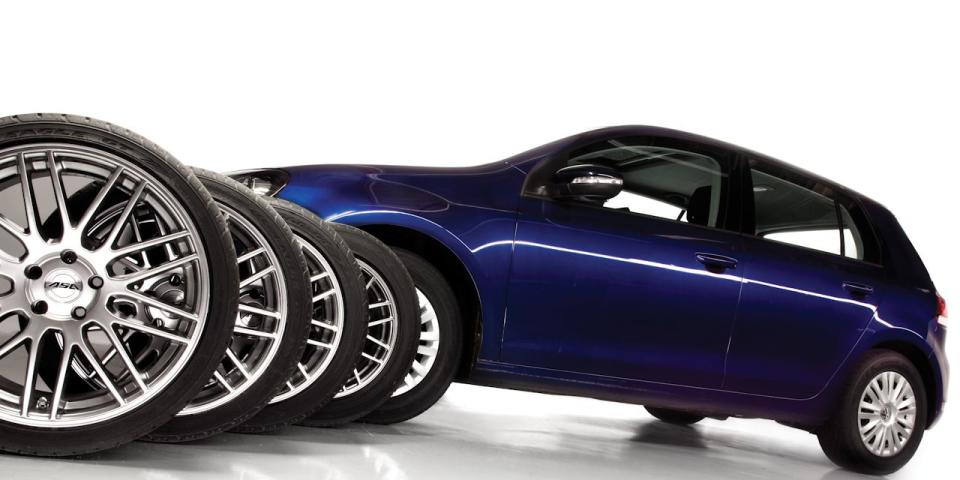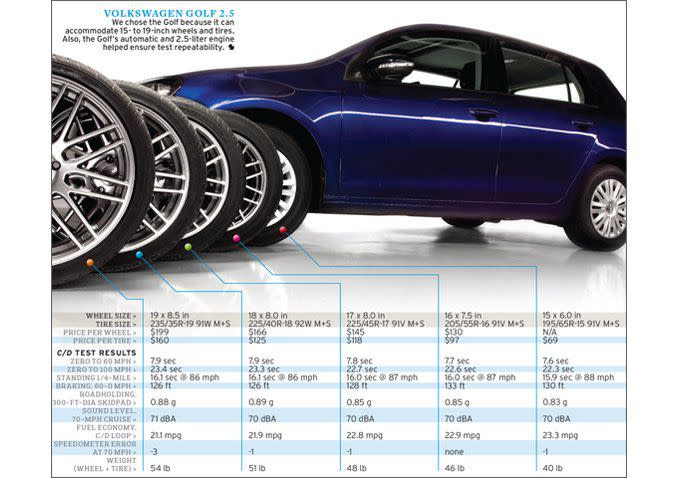Effects of Upsized Wheels and Tires Tested



From the May 2010 Issue of Car and Driver
The aesthetic appeal of larger wheels and tires is undeniable, but what about the alleged performance benefits? In general, larger wheels are heavier, and additional weight hinders performance. To examine the effects of installing larger wheels and tires, also known as “plus-sizing,” we tested five wheel-and-tire combinations-ranging from 15 to 19 inches-on a 2010 Volkswagen Golf and got a good sense of what is gained and lost in the process.
The plus-size concept basically works like this: As the wheel gets larger in diameter, the size of the tire’s sidewall must shrink to maintain the tire’s overall diameter. Keeping the overall tire diameter roughly the same is crucial to keeping the gearing the same and the speedometer accurate, as well as for making sure the wheels and tires fit within the fenders. But larger-diameter wheels and tires are often available only in enlarged widths as well. For more information on plus-sizing and details on what will and won't fit your car, call the folks at Tire Rack (800-981-3782) or visit tirerack.com.
Our test employed nearly identical Goodyear Eagle GT ultra-high-performance all-season tires in all five sizes, inflated to manufacturer-recommended pressures. We say that the tires were nearly the same because the 15-, 16-, and 17-inchers have a lower speed rating (V, or a top speed up to 149 mph) than the 18- and 19-inch tires’ W-rating (up to 168 mph). This, however, was as close as we could get to testing the same tire in every size. We used the stock steel wheels for the 15-inch test and went to the aftermarket for the larger wheels, as most owners would do. The aftermarket wheel we chose was a cast-aluminum ASA GT1, which is available in 16- to 19-inch sizes on the Golf. It’s obvious from the test that as wheels and tires grow in size, they also grow in weight. Here’s how the test shook out:
What’s immediately apparent from the results is that as the wheel-and-tire packages get larger and heavier, acceleration and fuel economy suffer. Neither is a huge surprise, but we measured a 10-percent drop in fuel economy and a four-percent degradation in 0-to-60-mph acceleration from the 15s to the 19s, which is worth considering should you be thinking about “going big.” Increasing wheel diameter and width, in turn, requires wider tires with shorter and stiffer sidewalls, which we found will increase skidpad grip, but as our test shows, there is a limit to this assertion. The 19-inch package came with the widest tires (235/35R-19) mounted to the widest wheels (8.5 inches), but this setup had less grip around the skidpad than the narrower 225/40R-18s on 8.0-inch-wide wheels. We asked the folks at Goodyear why that might be, and they postulated that the added width may have given the outside tire more grip, which would increase body roll and could therefore decrease the load on the inside tire enough to lose 0.01 g on the skidpad.

Surprisingly, the 225/40R-18s showed a big skidpad advantage compared with the 225/45R-17s (0.89 g versus 0.85 g). We suspect the difference is due to the grippier compound (lower wear rating) of the W-rated 18s. Goodyear does offer a W-rated GT in the 225/45R-17 size, which is what we intended to use, but Goodyear sent us the V-rated version for our test.
Subjectively, both the 17-inch and 18-inch wheels and tires were in the sweet spot of grip, braking performance, ride comfort, and steering feel. Moving from 17-inchers to 18s barely degrades ride quality, and the additional grip is welcome. We’d guess that a W-rated Eagle GT in the 17-inch size would come close to matching the grip of the W-rated 18, but we can’t say for certain without testing. Even with V-rated rubber, the per-formance of the 17s felt similar to that of the 18s. But since the 18-inch setup costs only $112 more than the 17-inch package, we’d probably opt for the 18s if we lived in a region with smooth roads and looks were a priority.
We do know that the heavy, 19-inch setup suffered from the most impact harshness and seemed to tax the suspension the most. In contrast, the two smallest wheel-and-tire combos showed a propensity for more understeer on the skidpad but provided a more controlled and supple ride. And although it didn’t register on the dBA-meter, the 15- and 16-inch arrangements had a more pleasant sound quality than the larger tires.
The 19-inch wheels definitely look the coolest. But the 17- and 18-inch setups offer a better compromise of grip, acceleration, price, and ride harshness, so we’re not surprised VW uses 17- and 18-inch sizes on its hot Golf, the GTI. If it’s acceleration you’re after, stick with the smaller, lighter wheels and tires. And remember, unless you believe it is better to look good than to feel good, take our advice and stay away from extremely low-profile sidewalls and massively heavy wheels.
• 2014 Geneva Auto Show: Full Coverage
('You Might Also Like',)

 Yahoo Autos
Yahoo Autos 

